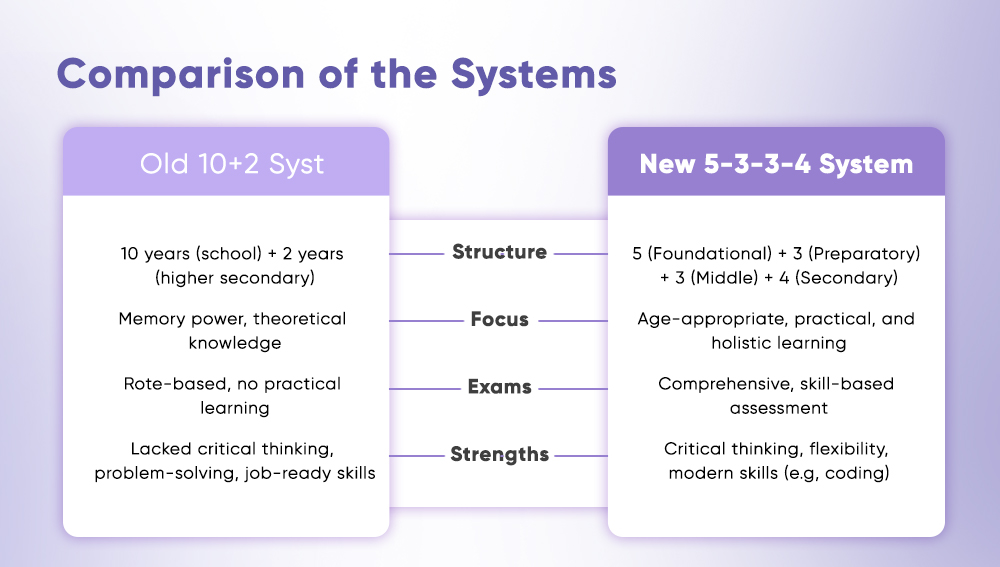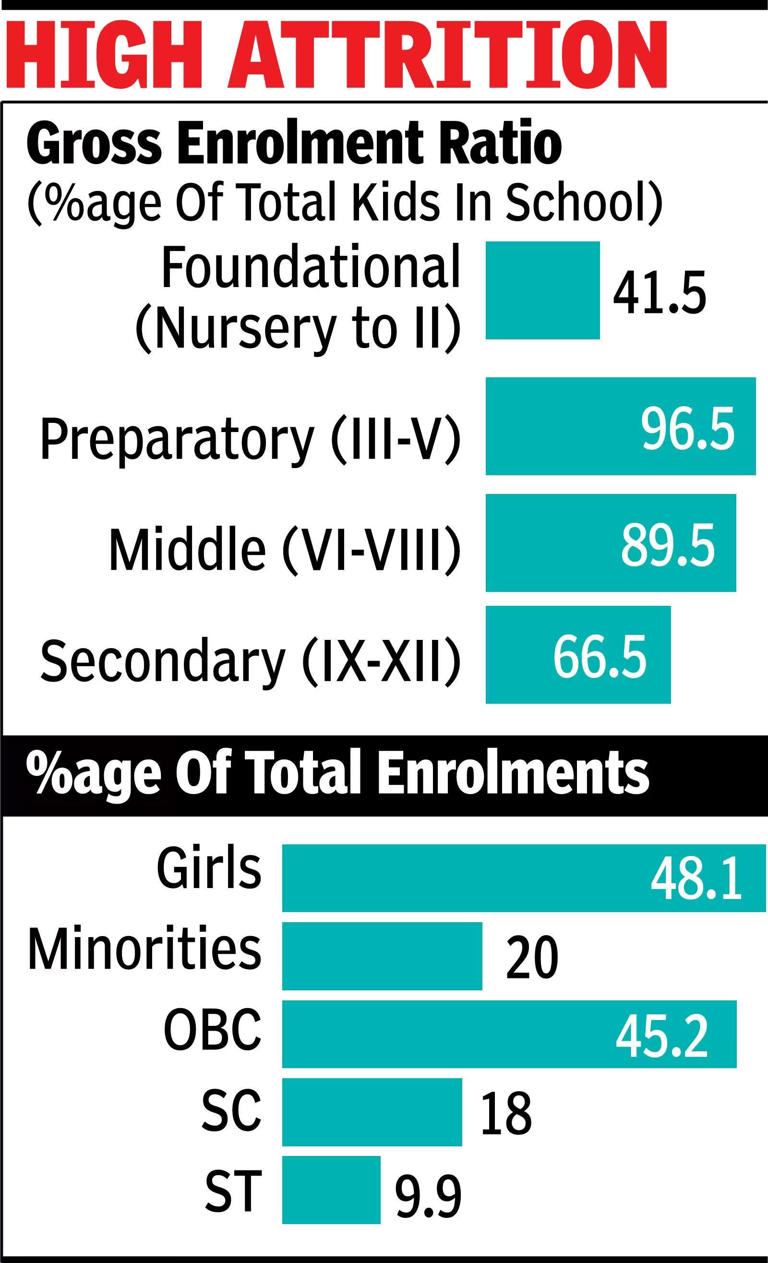Governance
State of School Education In India
- 10 May 2025
- 10 min read
For Prelims: National Education Policy (NEP) 2020, Mid Day Meal Scheme, Sustainable Development Goal, NIPUN, ASER 2024, Elementary Education
For Mains: State of Elementary School Education In India, Significance of Government Policies & Interventions in Education and Issues Related to Children.
Why in News?
India's school education system is struggling, with the ASER 2024 report revealing that only 23.4% of Class 3 students in government schools can read a Class 2-level text. Public education spending remains at 4.6% of GDP, falling short of the 6% target set by National Education Policy (NEP), 2020.
Structure of School Education in India
- India’s school education system is transitioning in phased manner from the 10+2 format to the 5+3+3+4 structure under the NEP, 2020.
- This revamped model spans ages 3-18, integrating early childhood care and education. It comprises:
- Foundational Stage (5 years): 3 years pre-school + Classes 1–2
- Preparatory Stage (3 years): Classes 3–5
- Middle Stage (3 years): Classes 6–8
- Secondary Stage (4 years): Classes 9–12
What are the Challenges Faced by India’s School Education System?
- Learning Poverty and Poor Outcomes: Despite a high Gross Enrolment Ratio at the elementary level, foundational learning is severely deficient.
- According to ASER 2024, 76.6% of Class 3 students remained unable to read the text, which was available in 19 languages.
- According to the World Bank’s Learning Poverty Index (percentage of 10-year-olds unable to read a basic text), India's learning poverty rate increased to 70% post Covid-19, from 55% in 2019.
- Teacher Shortage and Ineffective Training: India faces a severe teacher shortage with over 1 million vacancies, especially in rural areas, leading to high pupil-teacher ratios (up to 47:1) and compromised teaching quality.
- States like Uttar Pradesh and Madhya Pradesh have over 100,000 vacancies, and a notable percentage of teachers remain underqualified.
- High Dropouts & Gender Disparity: According to the Economic Survey 2024–25, dropout rates are 1.9% at primary, 5.2% at upper primary, and 14.1% at secondary levels.
- According to UDISE Plus data for 2022-23 and 2023-24, boys have higher dropout rates than girls, especially at the secondary level.
- Infrastructure Gaps: According to UDISE+ 2023-24 data, only 43.5% of government schools have computers for teaching, compared to 70.9% in private, unaided schools.
- Despite basic amenities in over 90% of schools, infrastructure gaps persist.
- 1.52 lakh lack electricity, 67,000 lack functional toilets, and only 33.2% of government schools have disabled-friendly toilets, most of which are non- functional.
- Despite basic amenities in over 90% of schools, infrastructure gaps persist.
- Regional Disparity: States like Bihar, Uttar Pradesh, and Maharashtra have the highest dropout rates.
- In West Bengal, 79% of schools are at the foundational and preparatory levels, but only 11.6% provide secondary education, which increases the risk of dropouts.
- Curriculum and Pedagogical Challenges: India’s school system remains focused on exams and rote learning, with little space for creativity, critical thinking, or life skills.
- Many students, especially first-generation learners, struggle due to lack of local language adaptation.
- Regulatory and Governance Deficits: India’s school regulation focuses more on inputs than learning outcomes, lacking an independent quality monitoring body.
- Though NEP 2020 proposes a State School Standards Authority (SSSA) for outcome-based regulation, its slow implementation and absence of transparent benchmarks hinder accountability and reform.
What is the State School Standards Authority (SSSA)?
- About: SSSA is an independent regulatory body proposed under the NEP 2020, aimed at overseeing and ensuring the quality of education in schools across India.
- Functions:
- The SSSA is responsible for setting academic and operational standards, assessing student performance/
- Promoting accountability, providing transparent information to parents, and regulating both public and private schools to ensure uniform quality across all educational institutions.
- Recommendations for Effective Implementation:
- The SSSA should be established as an autonomous statutory body with diverse stakeholder representation, ensuring transparency, accountability, and conflict-free governance.
- It must set practical, ambitious standards with effective implementation, learning from past regulatory shortcomings of the RTE Act, 2009.
What is the Institutional Framework of School Education in India?
|
Regulatory Body |
Functions |
|
Central Advisory Board of Education (CABE) |
It is the highest advisory body for both the Central and State Governments. Acts as a platform for resolving educational issues. |
|
National Council of Educational Research and Training (NCERT) |
NCERT, established in 1961, supports the Central and State Governments in improving school education, nodal agency for the Universalisation of Elementary Education. |
|
State Council of Educational Research and Training (SCERT) |
It is responsible for educational research and teacher training at the state level and implements the National Policy on Education within the states. |
|
Central Board of Secondary Education (CBSE) |
CBSE is a national-level board that conducts public exams and maintains a standardized curriculum for affiliated schools.
|
What are the Government Initiatives Related to Education?
What Measures Should be Taken to Improve School Education in India?
- Focus on Learning Outcomes: Focus should be on learning outcomes by using assessments like the National Achievement Survey (NAS) and implementing performance-linked funding.
- Scale up the NIPUN Bharat Mission to ensure foundational literacy and numeracy for all children by Grade 3, supported by trained teachers and community involvement.
- Reform Teacher Training and Recruitment: Strengthen teacher education with practical pedagogy and ongoing professional development.
- Equitable Access to Education: Bridge the urban-rural divide by investing in public education, especially in rural and underserved areas, ensuring every child receives quality education, regardless of socio-economic background.
- Technology Integration: Expand initiatives like DIKSHA (Digital Infrastructure for Knowledge Sharing) and NDEAR to provide digital access, especially in rural areas.
- Adopt a blended learning model and integrate AI-driven personalized learning and smart classrooms to enhance education quality and accessibility.
- Establish Independent Regulatory Oversight: Operationalise the State School Standards Authority (SSSA) as recommended under NEP 2020 to set clear quality benchmarks,
- Enable third-party assessments, and ensure accountability across all schools, moving beyond input-based regulation.
|
Drishti Mains Question: What are the key challenges in India’s school education system? How can the National Education Policy (NEP) 2020 address these issues? |
UPSC Civil Services Examination, Previous Year Question (PYQ)
Prelims
Q. Which of the following provisions of the Constitution does India have a bearing on Education? (2012)
- Directive Principles of State Policy
- Rural and Urban Local Bodies
- Fifth Schedule
- Sixth Schedule
- Seventh Schedule
Select the correct answer using the codes given below:
(a) 1 and 2 only
(b) 3, 4 and 5 only
(c) 1, 2 and 5 only
(d) 1, 2, 3, 4 and 5
Ans- (d)
Mains
Q1. How have digital initiatives in India contributed to the functioning of the education system in the country? Elaborate on your answer. (2020)
Q2. Discuss the main objectives of Population Education and point out the measures to achieve them in India in detail. (2021)









